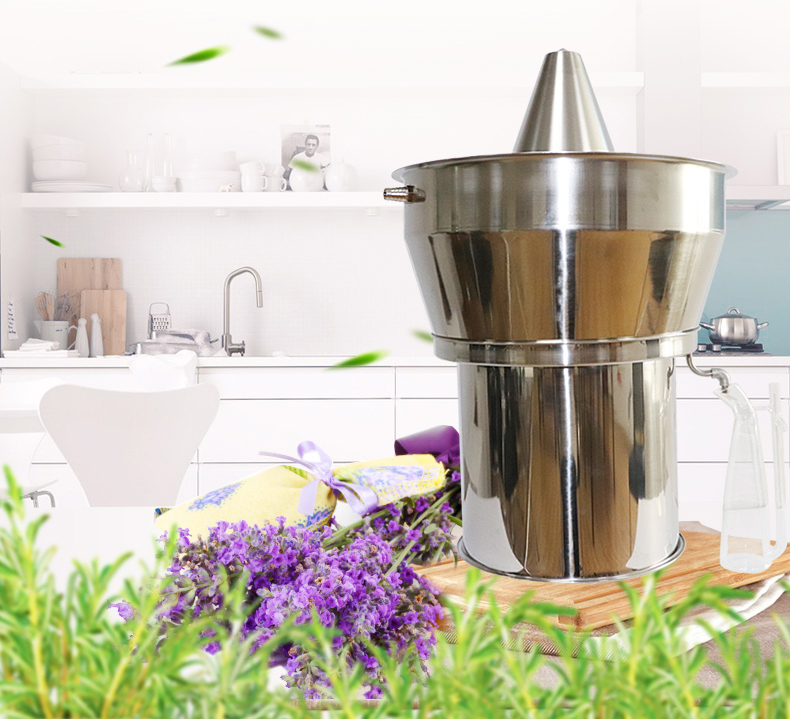Have you ever wondered how we get the essential oils that we use each day? They don’t grow on trees, at least not directly! All of those natural ingredients, many of which do grow on trees, are turned into essential oils by one of two methods, either distillation or expression. Distillation is more common because it’s thought to be more efficient and it can be used at home to make your oils.
What is the Purpose of Distilling Essential Oils?


The purpose of distilling essential oils is to remove the components that we want to use for our treatments and leave the rest behind. Rather than having to squeeze a rub lavender twigs on ourselves, it’s possible to use only the oil in a more concentrated form.
What is Distillation?
To create the concentration essential oils that we use today it’s necessary to distill the natural plants down into liquid oil. To treat certain ailments, particularly on your skin, larger amounts of oil are needed, and this wouldn’t be practical if you were to try and use the natural plant material.
Instead, we use a process called distillation to get the best out of those plant materials. Distillation has been used throughout history and is thought to have existed for at least five thousand years. It’s not only used for essential oils, but also for water purification, crude oil and other ingredients too.
During distillation, the plant material is placed on a grid inside of a still and using one of many methods it is heated to remove the volatile components. These then rise through the top of the still and through a pipe which leads to the condenser. Here the condenser cools the vapor which will then drip down into a collection bucket below.
These distillation processes often require water in the form of steam or hot water but because oil and water do not mix, when they condense the oil will sit on top of the water. Occasionally an oil is denser than the water, such as with clove oils, but in either case, the oil can be siphoned off for bottling.
Distillation is relatively efficient because it’s simplistic and allows for the maximal extraction of oil because little machinery comes into contact with the plant material. As a result, some believe that oils from distillation can be purer and of higher quality.
Simple Distillation
Simple distillation is a procedure by which two liquids with separate boiling points can be separated. This is a great way to remove the water that is left over in the final collection pot. Oil will boil at a far higher temperature than water in most cases, and therefore you can heat it gently to let the water evaporate, leaving a concentrated oil for use.
Water Distillation
Although not a very common method, water distillation has historically been used for thousands of years. The plant material will come into direct contact with the water, and therefore this method is used for flowers because steam will cause flowers to clump, making it hard for the vapor to pass through.
The water is heated to a hot temperature so that the oils are extracted from the natural plant material, and then the water can be removed so that the oil is purer and more concentrated.
Water and Steam
Rather than only using steam or water separately, it is possible to combine the two processes. The method is ideal for herb and leaf material together. The water remains below the plant material which is placed on a metal grate, while the steam comes from a separate container and heats the plant matter from the side.
Steam Distillation
Undoubtedly the most common method, steam distillation is incredibly efficient and can be used for plant material and also for smaller amounts of flowers if they are carefully laid. Steam is injected into the still at a higher pressure and temperate than is used in either water and steam or water distillation.
This higher temperature can cause more of the oils to be extracted, and therefore each pound of plant material can produce a slightly more considerable amount of essential oils. The oils and steam then condensate in a separate still where the oils can be siphoned off and bottled for use.
Percolation or Hydro-diffusion
The final method of distillation is a more modern process which is similar to steam distillation except that rather than pumping the steam in through the bottom, with percolation it comes in through the top. This method of distillation can be more efficient and is thought to be useful in the extraction of oils from more robust materials such as dill, fennel, and some woods.
Essential Oil Adulteration
The reason why distillation is used by many companies is that they believe that it can lead to the purest of oils. A problem with some cheaper companies is essential oil adulteration which is when they are either diluted or contaminated with synthetic materials.
Purity and quality are incredibly important because they can contribute to the effectiveness of an oil. If it’s impure, then you’re either using random ingredients. If it’s diluted with water, then you’re not getting the correct dosage from the treatment. Both of these factors can impact your treatment and can reduce the effectiveness of the oils.
Contamination can occur either in the fields where the plants are grown or in the distillation or extraction process. While distillation uses evaporation and condensation which allows us to extract the pure oils with far less contamination.

2 Comments. Leave new
how best to filter the essential oil from herbal residue
I need a practical demonstration of the distilling process of Lemongrass oil through video recording.